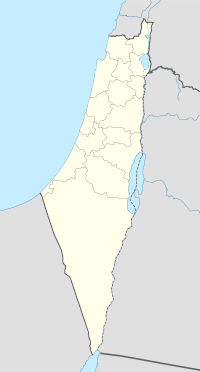Beit Far
| Khirbat Bayt Far | |
|---|---|
| Arabic | خربة بيت فار |
| Name meaning | the ruin of the house of the mouse |
| Subdistrict | Ramle |
| Coordinates | 31°48′03″N 34°54′57″E / 31.80083°N 34.91583°ECoordinates: 31°48′03″N 34°54′57″E / 31.80083°N 34.91583°E |
| Palestine grid | 142/134 |
| Population | 300 (1945) |
| Date of depopulation | April 7, 1948 |
| Current localities | Tal Shahar |
Khirbat Bayt Far was a Palestinian village in the Ramle Subdistrict of Mandatory Palestine, located 14 km south of Ramla. It was depopulated during the 1947–48 Civil War in Mandatory Palestine on April 7, 1948.
Ceramics from the Byzantine era have been found here.
In 1838, in the late Ottoman era, it was noted as a village in ruins.
In 1882, the Palestine Exploration Fund's Survey of Western Palestine (SWP) found here: "Walls and foundations, apparently modern, with caves and a spring."
In the 1922 census of Palestine conducted by the British Mandate authorities, Bait Far had a population of 28 Muslims, decreasing in the 1931 census to 26 Muslims, in a total of 11 houses.
In 1944/45 the village had a population of 300 Muslims with a total of 5,604 dunums of land. Of this, 19 dunums were for plantations and irrigable land, 5,337 dunums were for cereals, while a total of 248 dunams were classified as non-cultivable areas.
On 11 January 1948, Kfar Uriah was attacked by Arabs who came from neighboring Beit Jiz and Khirbet Beit Far.
In 1948, Beyt Pe'er was founded on village land, it later changed its name into Tal Shahar.
In 1992 the village site was described: "All that is left of the village are debris and girders heaped together in a small area. The site is ringed by carob trees. The remains of an uprooted olive grove lies to the north and east."
...
Wikipedia

